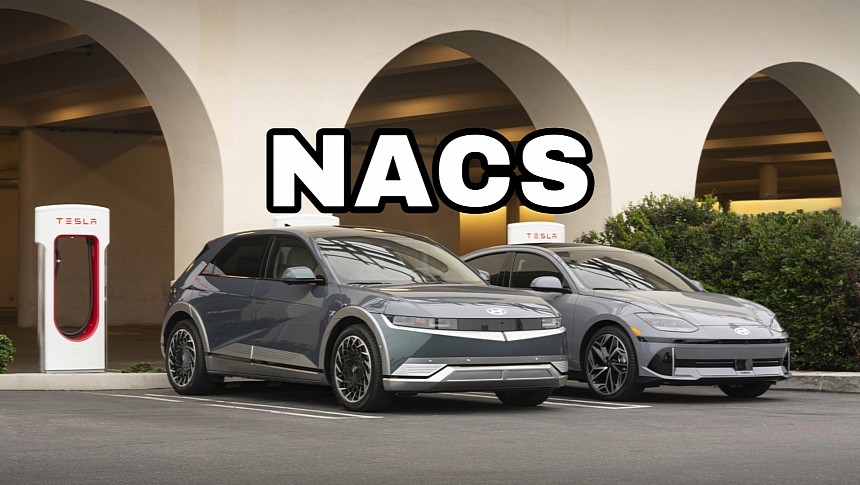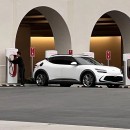Hyundai is the latest carmaker to join the NACS fray but the first to use the 800-volt architecture that makes the switch. It's unclear how the Korean carmaker will solve this conundrum, considering that the experience of charging 800-volt EVs at Supercharger stations has been disappointing.
Tesla open-sourced the North American Charging Standard (NACS), inviting other carmakers in North America to use their charging plug. Since the Tesla Supercharger network is the most extensive DC fast-charging network in the world, many EV makers adhered to the new standard, which quickly gained traction. The first to announce the new charging plug was Ford in May, followed by GM and Rivian in June.
Soon, many carmakers pledged to adopt the NACS plug for their EVs sold in the US and Canada: Volvo, Polestar, Mercedes-Benz, Nissan, Jaguar Land-Rover, Fisker, Honda, and Acura. The most notable exceptions to this list are brands owned by BMW, Volkswagen, Toyota, and Stellantis and those who produce EVs with an 800-volt electrical architecture. So far, these are Porsche, Hyundai, Kia, and Lucid.
The GMC Hummer EV and the upcoming Chevrolet Silverado EV/GMC Sierra EV are in a class of their own. Their electrical architecture allows charging at both 400 volts and 800 volts by connecting their two battery packs in parallel or series, respectively. This explains why GM was among the first to adopt NACS, despite Tesla Supercharger offering only 400-volt chargers for now.
Among other EV models using an 800-volt architecture are the Hyundai Ioniq 5, Hyundai Ioniq 6, Kia EV6, Genesis GV60, and Porsche Taycan. None of them, except for the Taycan, have had a good experience charging at a Tesla Supercharging, mainly because their internal DC-DC converter is limited to 50 kW. This is a serious shortcoming, as the DC-DC converter is essential to converting the 400 volts delivered by the Supercharger station to the 800 volts needed by the car's battery.
Charging a big battery at 50 kW takes a lot of time, which is why carmakers with 800-volt EVs have not adopted NACS earlier. Thankfully, although it is optional, Porsche offers a 150-kW DC-DC converter for the Taycan. It's well worth it, though, as it allows much faster charge times at Supercharger stations.
Hyundai is the first maker of 800-volt EVs to adopt the NACS, with Kia and Genesis, both owned by Hyundai, likely to follow. Hyundai EVs will come with a NACS plug in the US in Q4 2024, with Canada following in the first half of 2025. Existing Hyundai EVs with CCS plugs will be able to access the Supercharger network starting in Q1 2025, and Hyundai will offer an adapter to those customers. It will also provide a CCS adapter to buyers of EVs that will have a NACS port, enabling access to current CCS fast chargers. It's still unclear whether these adapters will be offered free of charge.
Hyundai is also involved in a joint venture with BMW, GM, Stellantis, and Mercedes-Benz to build a nationwide charging network in the US. The plan is to install 30,000 DC fast-charging dispensers by 2030, with the first stations starting operations in 2024. It's unclear where this project is going, considering that Tesla Supercharger is the world's best and most extensive charging network.
Soon, many carmakers pledged to adopt the NACS plug for their EVs sold in the US and Canada: Volvo, Polestar, Mercedes-Benz, Nissan, Jaguar Land-Rover, Fisker, Honda, and Acura. The most notable exceptions to this list are brands owned by BMW, Volkswagen, Toyota, and Stellantis and those who produce EVs with an 800-volt electrical architecture. So far, these are Porsche, Hyundai, Kia, and Lucid.
The GMC Hummer EV and the upcoming Chevrolet Silverado EV/GMC Sierra EV are in a class of their own. Their electrical architecture allows charging at both 400 volts and 800 volts by connecting their two battery packs in parallel or series, respectively. This explains why GM was among the first to adopt NACS, despite Tesla Supercharger offering only 400-volt chargers for now.
Among other EV models using an 800-volt architecture are the Hyundai Ioniq 5, Hyundai Ioniq 6, Kia EV6, Genesis GV60, and Porsche Taycan. None of them, except for the Taycan, have had a good experience charging at a Tesla Supercharging, mainly because their internal DC-DC converter is limited to 50 kW. This is a serious shortcoming, as the DC-DC converter is essential to converting the 400 volts delivered by the Supercharger station to the 800 volts needed by the car's battery.
Charging a big battery at 50 kW takes a lot of time, which is why carmakers with 800-volt EVs have not adopted NACS earlier. Thankfully, although it is optional, Porsche offers a 150-kW DC-DC converter for the Taycan. It's well worth it, though, as it allows much faster charge times at Supercharger stations.
Hyundai is the first maker of 800-volt EVs to adopt the NACS, with Kia and Genesis, both owned by Hyundai, likely to follow. Hyundai EVs will come with a NACS plug in the US in Q4 2024, with Canada following in the first half of 2025. Existing Hyundai EVs with CCS plugs will be able to access the Supercharger network starting in Q1 2025, and Hyundai will offer an adapter to those customers. It will also provide a CCS adapter to buyers of EVs that will have a NACS port, enabling access to current CCS fast chargers. It's still unclear whether these adapters will be offered free of charge.
Hyundai is also involved in a joint venture with BMW, GM, Stellantis, and Mercedes-Benz to build a nationwide charging network in the US. The plan is to install 30,000 DC fast-charging dispensers by 2030, with the first stations starting operations in 2024. It's unclear where this project is going, considering that Tesla Supercharger is the world's best and most extensive charging network.







